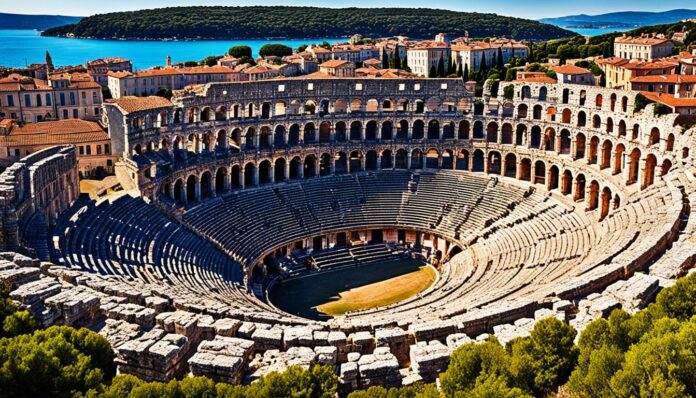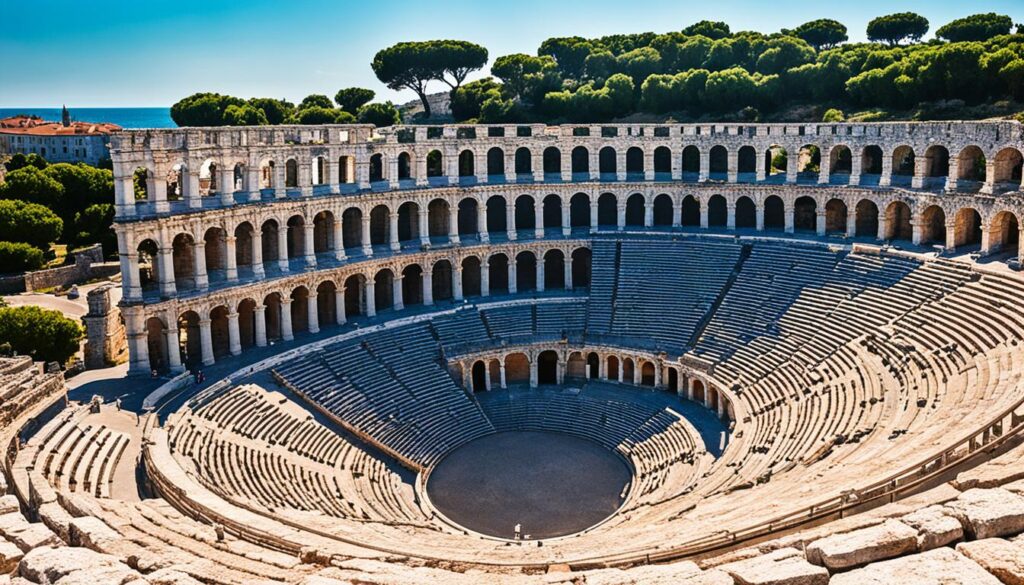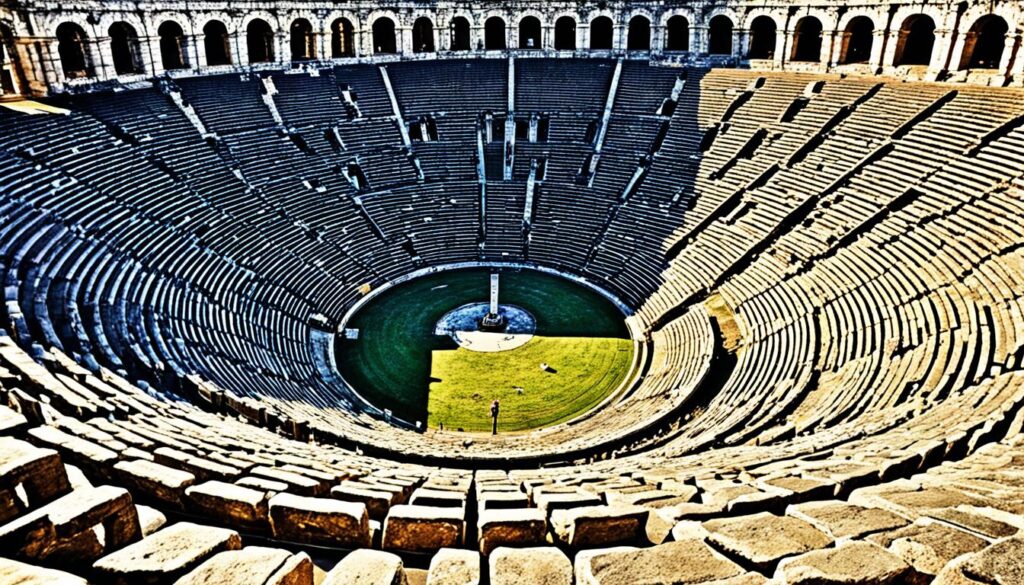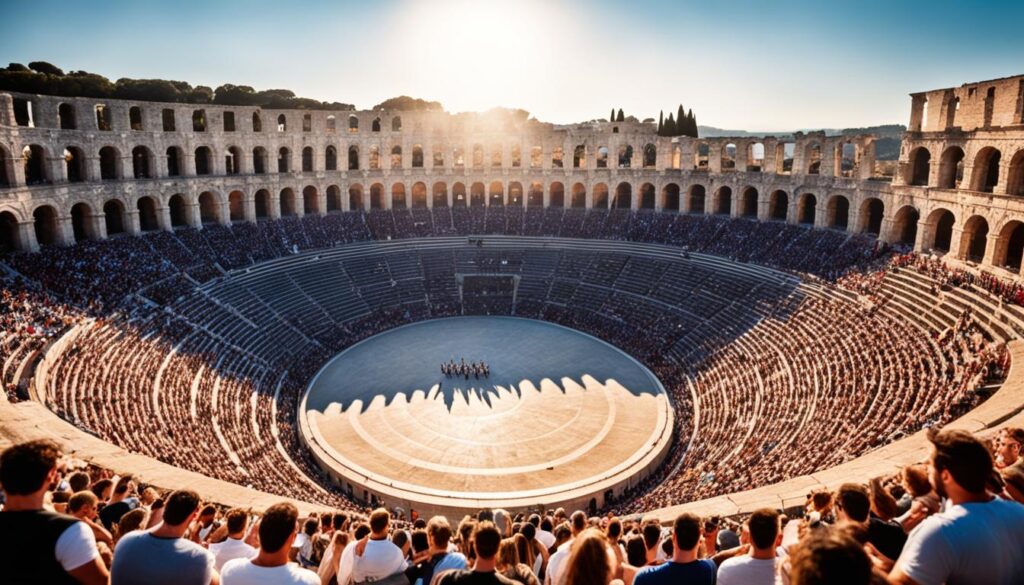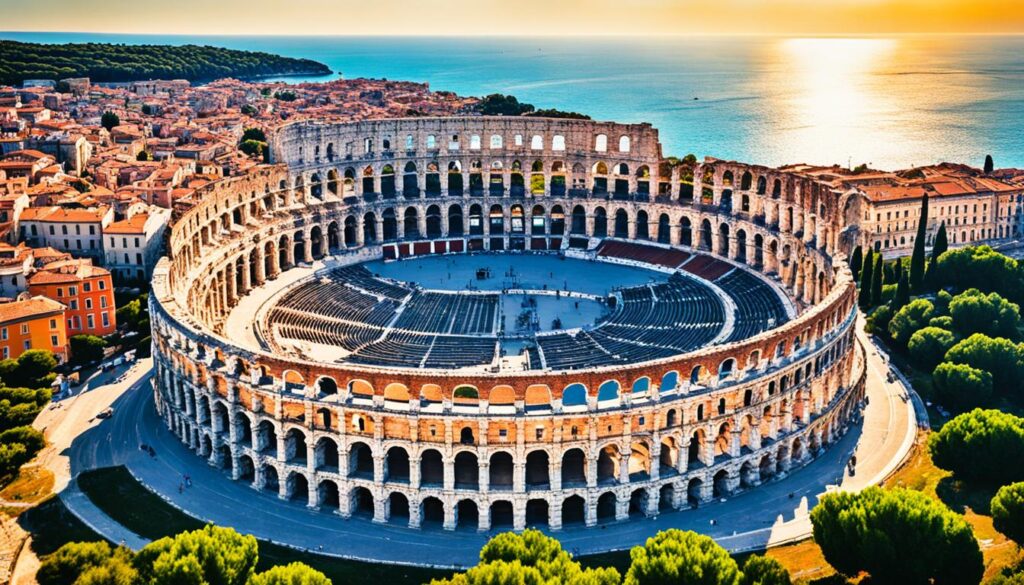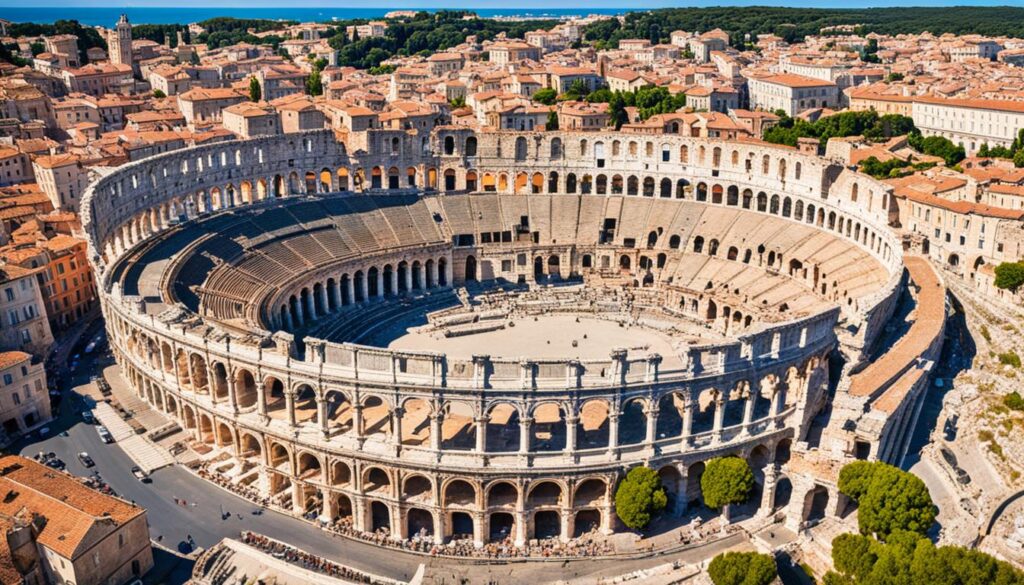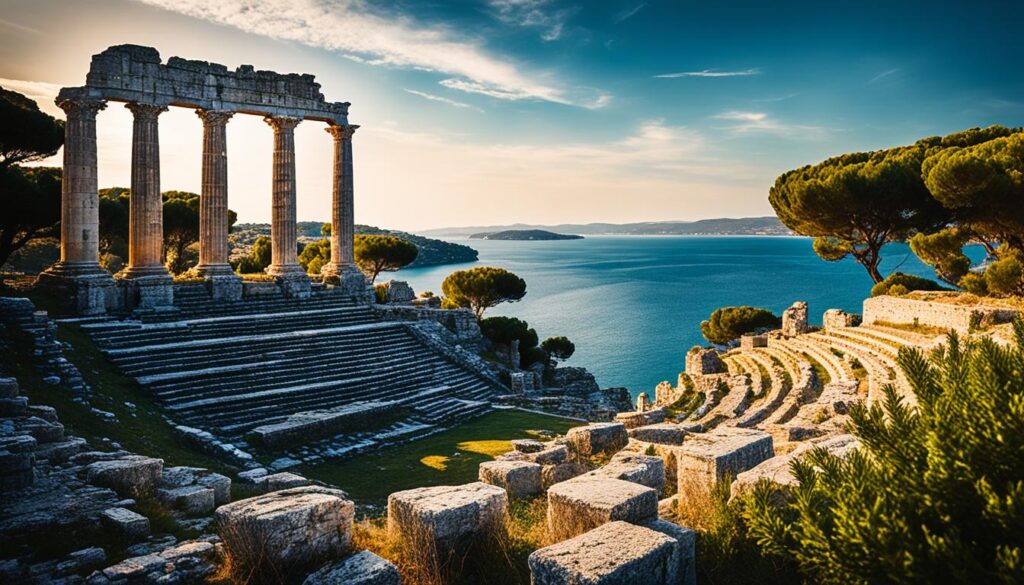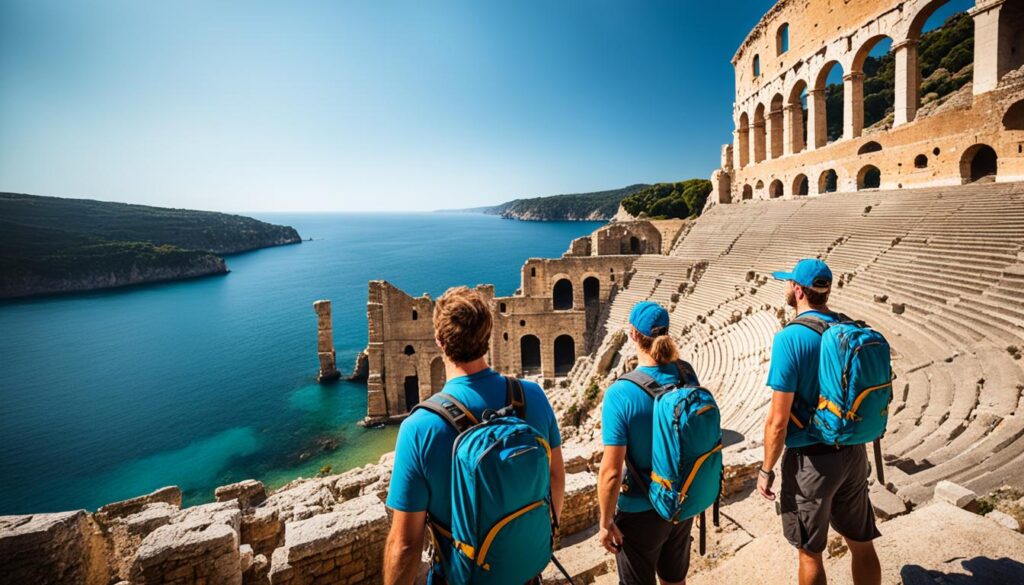Ever wondered about the secrets hidden under a modern city? In Pula, Croatia, ancient Roman history is everywhere. It’s not just ruins. Pula’s past is full of stories and incredible buildings from Roman times. Let’s explore these and feel like we’re traveling back in time.
Imagine walking in the footsteps of ancient emperors and gladiators. Pula’s history is rich and fascinating. It was important in the Roman Empire. Here, you can see amazing Roman architecture and learn the stories behind these ancient places.
Ready to explore Pula’s ancient treasures? Let’s dive into this city’s Roman history together. We’ll see its beautiful old wonders and learn amazing tales.
The Ancient Roman City of Pula
Explore the origins and growth of Pula, an ancient Roman city on the Adriatic coast. It was a key Roman settlement, important for trade and military. Pula played a big role in spreading the Roman Empire’s reach.
Founded over 3,000 years ago, Pula started as a small prehistoric village. It turned into a bustling Roman colony thanks to its location by the Adriatic Sea. This made Pula crucial for connecting the empire to other Mediterranean areas.
Pula became a busy place with a strong economy. It’s strategic spot helped grow its port. This allowed for trade in goods like olive oil, wine, and metals.
Pula was also key for military reasons. It had a big Roman naval base. This base was vital for keeping the eastern Adriatic Sea safe from invaders.
“Pula’s rise as an ancient Roman city shows the Roman Empire’s impressive architecture and strategic success.” – Roman historian
The city’s layout featured amazing Roman infrastructure. This includes well-kept roads, aqueducts, and public buildings. These showcased the Romans’ advanced building skills.
Pula: A Cultural Melting Pot
Pula was more than a trade and military hub; it was a place of diverse cultures. As the empire grew, people from various places moved to Pula. They added to the city’s rich cultural scene.
Pula’s mix of architectural styles shows Roman, Greek, and Byzantine touches. This blend of cultures made Pula unique and captivating.
Explore Pula’s Historical Treasures
Visiting Pula lets you see its great history. Start at the Pula Arena, a well-kept Roman amphitheater.
Centuries ago, the arena was the site of gladiator fights and shows. Now, it hosts concerts and events. This lets visitors feel like they’re in ancient Rome.
| Must-Visit Roman Sites in Pula | Location |
|---|---|
| Pula Arena | Pula city center |
| Temple of Augustus | Pula city center |
| Twin Gates | Pula city center |
| Forum | Pula city center |
| Arch of the Sergii | Pula city center |
A City Immersed in History
Every part of Pula tells a tale of its rich past. The old town mixes Roman ruins with medieval architecture. This mix creates a unique feel that draws in explorers.
The city is full of historical sites like the Temple of Augustus and the Twin Gates. These structures show the long-lasting impact of the Romans. They amaze visitors with their beauty and historical value.
Discover Pula’s secrets by exploring its archaeological sites and museums. Learn about the Romans and their influence on Pula.
Visit Pula to travel back in time. Admire its architecture, enjoy its culture, and see how the Romans shaped this Adriatic treasure.
Roman Architecture in Pula
Discover the remarkable beauty of Roman architecture in Pula. As you explore, the majestic buildings will capture your heart. The grand Pula Arena and the elegant Temple of Augustus show how Romans made their mark here.
The Pula Arena is an awe-inspiring sight. Built in the 1st century AD, it shows the Romans’ architectural skill. It could hold up to 23,000 people and was for gladiator fights. Today, it still amazes visitors with its size and shape.
“The Pula Arena is an architectural marvel, blending seamlessly with the picturesque cityscape. Its grandeur transports you back in time, offering a glimpse into the scale and majesty of Roman engineering.”
At Pula’s center is the Temple of Augustus. It was built for Emperor Augustus. The temple has stunning Corinthian columns and carvings of myths. Inside, its calm beauty and enduring craft impress all who visit.
Pula’s Roman sites will astonish anyone who loves architecture or history. The city takes care of these ancient treasures. They let us see the Roman Empire’s greatness up close.
Table | Roman Architectural Marvels in Pula
| Structure | Description |
|---|---|
| Pula Arena | An elliptical amphitheater that hosted gladiatorial contests, showcasing the grandeur of Roman entertainment. |
| Temple of Augustus | A beautifully preserved temple honoring the first Roman emperor, Augustus, adorned with intricate columns and friezes. |
Let the spirit of ancient Rome inspire your visit to Pula. Marvel at the Pula Arena and Temple of Augustus. These structures are a tribute to Roman engineering and art. Plan a trip to see Pula’s wonders and walk through history.
The Pula Amphitheater: A Glimpse into Gladiatorial History
In Pula’s center, the Pula Amphitheater is a stunning link to ancient entertainment. Built in the 1st century AD, it’s among the most well-kept of its kind globally. This ancient arena lets us see what thrilling combat in the past looked like.
This amphitheater carries the legacy of the Roman Empire’s grandeur. When you walk through its seating and corridors, you feel the buzz of past battles. You can almost hear the crowd and feel the intensity that filled this huge space.
Explore stories and legends of gladiators’ epic fights within its walls. As you move around, picture the grandeur of past events, from ferocious battles to exotic animal displays.
The Architecture of the Pula Amphitheater
Shaped like an ellipse, the amphitheater is large, being about 130 meters by 100 meters. Its limestone walls stand tall at 32 meters, dominating the city’s landscape. The arena welcomed guests through four main gates. Inside, a complex of arches and stairways showed the Romans’ advanced building skills.
Its design made it easy to manage crowds, with special paths for smooth movement. Seats were arranged by social rank, showing Rome’s focus on detail and equal viewing pleasure for everyone.
The Amphitheater Today
The Pula Amphitheater remains a proud symbol of Pula’s Roman past. Now, it hosts cultural events like concerts and plays. Guided tours offer a peek into its fascinating history and architecture.
Standing in the arena, you’re surrounded by stories from ancient times. The Pula Amphitheater brings history to life, letting us marvel at the gladiators and the world of ancient Rome.
Historical Landmarks in Pula
As you walk through Pula, you’ll find many historic sites. These places show the city’s long history. They highlight Roman impact and bring history to life.
The Roman Gates
The Roman Gates in Pula are very famous. In the past, they welcomed people with their large size. Walk through these gates to feel the ancient vibe.
The Arch of the Sergii
The Arch of the Sergii is beautiful and old. It was built to honor the Sergii family. Looking at it, you’ll see its detail and understand its importance.
The Roman Theater
Visit the Roman Theater to see history up close. This place used to hold exciting shows. Imagine the excitement of the audience here long ago.
Ancient Walls of Pula
The ancient walls protected Pula. They have seen many historic events. Walking by these walls, you can see great views of the city and sea.
“Pula’s historical landmarks are a testament to the enduring legacy of Roman influence and provide an immersive experience into the city’s captivating past.”
– Local Historian
Exploring Pula’s landmarks is like traveling back in time. These places are impressive and memorable for everyone.
| Historical Landmark | Description |
|---|---|
| Roman Gates | The magnificent entrance to Pula, adorned with stunning architecture. |
| Arch of the Sergii | A triumphal arch honoring the Sergii family and showcasing intricate details. |
| Roman Theater | A well-preserved amphitheater that once hosted thrilling performances. |
| Ancient Walls of Pula | Fortified walls that enclose the city, offering panoramic views of Pula and the Adriatic Sea. |
If you love history or ancient architecture, don’t miss seeing Pula’s landmarks.
The Roman Empire in Pula
In the beautiful city of Pula, you quickly see it’s more than just a pretty place. It was vital for the Roman Empire, acting both as an important center for administration and military.
“You may think of Pula as a minature Rome. The Eastern Adriatic was highly significant for the Romans due to its strategic location, and Pula was an essential outpost within their vast empire.” – Dr. Antonia Bosančić, Archaeologist
Pula was a lively center of trade and power under Rome. Its perfect position helped control trading paths, connecting Rome with the Mediterranean and the world. The city’s port was a key naval entrance, helping Rome’s reach grow in the area.
Pula and the Roman Emperors
Many Roman emperors shaped Pula over time. Emperor Vespasian built the famous Colosseum in Rome and improved Pula’s buildings. His sons, Titus and Domitian, furthered this work, adding more structures.
Emperor Augustus also saw Pula’s worth and made it stronger. The Temple of Augustus built for him shows his impact and how Rome left its mark on Pula.
The Military Might of Pula
Pula was a key defense point with great fortifications and military bases. It had a Roman fortress to protect the Adriatic Sea.
This strength protected the area and showed Pula’s role in the Roman military. Places like the Arch of the Sergii remind us of Pula’s past military glory.
A Legacy of Prosperity
Rome’s touch brought Pula wealth, growth, and new ideas. Its buildings show off Roman skills in engineering and architecture.
The Pula Arena and the Arch of the Sergii are marvels that show Rome’s ambition. They remind us of Pula’s rich history.
Walking through Pula, history is everywhere. Ancient ruins blend with modern life, offering a journey back in time.
Next, let’s discover what Pula offers, exploring ancient Roman sites that highlight this amazing city’s story.
Things to Do in Pula: Exploring Roman Sites
Start your Pula adventure by exploring its Roman legacy. The city boasts a rich array of archaeological wonders. These range from ancient ruins to museums and parks. They offer a deep dive into history for both the curious and the avid historian.
Explore Ancient Ruins
First, visit the famous Pula Amphitheater, known as the Arena. Built in the 1st century AD, this amphitheater is a window into ancient entertainment. Imagine the excitement of gladiator battles that took place here.
Don’t miss the Temple of Augustus, built for Rome’s first leader. Here, the well-kept Corinthian columns and reliefs showcase ancient Rome’s architecture. This temple from the 1st century BC is a testament to timeless craftsmanship.
Visit Informative Museums
The Archaeological Museum of Istria is a must for history buffs. It houses sculptures, pottery, and mosaics from Roman times. These artifacts offer a glimpse into daily life and cultural traditions back then.
Then, explore the Historical and Maritime Museum of Istria. It highlights Pula’s seafaring past with ship models and navigational aids. Discover how Pula’s location was pivotal for trade in the Adriatic Sea.
Discover Archaeological Parks
For a hands-on history lesson, check out Pula’s archaeological parks. Nesactium Park takes you back to before Rome ruled here. Explore ancient walls, temples, and graves that reveal stories of early settlers.
The Pula Fortress sits atop Kaštel hill, offering more Roman remnants. From baths to defensive structures, each find adds to the narrative of Pula’s ancient past.
Immerse Yourself in Roman History
Pula invites you to step into Roman history. Roaming through its sites, imagine the lively Roman streets. Stories and relics from yesterday will whisk you away to another time.
Experiencing Pula’s Roman heritage is unforgettable. Plan your visit now for an intriguing trip into the ancient world.
| Site | Description |
|---|---|
| Pula Amphitheater | Well-preserved Roman amphitheater that hosted gladiatorial contests and spectacles. |
| Temple of Augustus | Ancient temple dedicated to the first Roman emperor, showcasing intricate architecture. |
| Archaeological Museum of Istria | Houses a collection of artifacts that offer insights into Pula’s Roman history. |
| Historical and Maritime Museum of Istria | Explores Pula’s maritime heritage and its role in ancient trade routes. |
| Nesactium Archaeological Park | Showcases ruins from the Bronze and Iron Ages, offering a glimpse into the city’s pre-Roman past. |
| Pula Fortress | Reveals archaeological remains that highlight Pula’s Roman history. |
Pula Roman Ruins: Unveiling the Past
Dive into the magic of Pula’s Roman ruins, where ancient voices echo through time. Exploring these ruins, you feel connected to the past.
Travel back in time among the ruins. See the grand amphitheaters and beautiful temples. Each ruin tells a deep story from centuries ago.
“The ruins of Pula transport you to an era of grandeur and opulence. The intricate craftsmanship and architectural brilliance of these ancient structures are a testament to the ingenuity of the Roman Empire.” – Archaeologist Amelia Taylor
Start at the famous Pula Arena, an amphitheater that saw gladiatorial battles. The architecture is stunning. Imagine being among the ancient crowd, cheering on the gladiators.
Next, visit the Temple of Augustus, dedicated to the first Roman emperor. Its Corinthian columns are intricate, showcasing Roman architectural beauty.
Then, see the Arch of the Sergii, a beautiful triumphal arch. It honors Roman victories. Stand under it and picture the victory processions that happened here.
Don’t miss the Small Roman Theatre. It’s a cozy place that hosted amazing performances. Walk around and picture the plays that were performed.
Walking through Pula’s Roman ruins brings history to life. With every step, you touch a piece of the Roman Empire in this Adriatic gem.
Pula Roman Ruins
| Roman Ruins | Description |
|---|---|
| Pula Arena | An impressive Roman amphitheater that showcases the grandeur of gladiatorial battles and live performances. |
| Temple of Augustus | A well-preserved Roman temple dedicated to Emperor Augustus, featuring stunning architectural details. |
| Arch of the Sergii | A triumphal arch commemorating Roman military victories, adorned with intricate reliefs and carvings. |
| Small Roman Theatre | An intimate theater that offers a glimpse into the vibrant entertainment culture of ancient Pula. |
Embark on a journey through time at the Pula Roman ruins. Here, past splendor meets the present. Let these ancient stories impact your soul deeply.
Uncovering the Legacy: Exploring Roman History in Pula
Dive into the rich world of Roman history in Pula. This ancient city lets you travel back in time. See archaeological finds and cultural events that highlight the Roman Empire’s impact. Explore ruins and architectural marvels that have lasted for centuries.
Experience the past at the famous Pula Arena. This Roman amphitheater hosted battles and shows long ago. Walk down ancient streets. Admire the Temple of Augustus, a stunning piece of Roman architecture in the city’s center.
In Pula, discover many historical landmarks that reveal its history. The grand Arch of Sergii and the old city walls tell of Roman influence here. Each site has a story from the days of the Roman Empire.
| Key Roman Sites in Pula | Highlights |
|---|---|
| Pula Arena | The best-preserved Roman amphitheater in the world, showcasing the grandeur of ancient gladiatorial battles |
| Temple of Augustus | A beautifully preserved Roman temple dedicated to the first emperor of Rome, Augustus |
| Arch of Sergii | A triumphal arch commemorating a prominent Roman family in Pula |
| City Walls | Remnants of ancient fortifications that encircled the city, offering panoramic views over Pula |
Visit the Historical and Maritime Museum of Istria to learn about Pula’s Roman era. See artefacts and exhibits that tell the city’s story. Also, don’t miss the Pula Film Festival. It takes place in the Roman Amphitheatre and highlights Pula’s rich cultural scene.
Discover the history that intertwines with today’s life in Pula. For anyone interested in history or the Roman Empire’s legacy, Pula offers an unforgettable trip. Explore Roman history here and see how past and present merge beautifully.
Conclusion
Dive into the world of Pula’s Roman history and let the ancient city take you back in time. Admire the architectural wonders that show the power of the Roman Empire. The Pula Arena and the Temple of Augustus highlight Roman building prowess.
In Pula, discover historical spots throughout the city. Ancient Roman gates and well-kept walls give a peek into Pula’s rich past. These places highlight the lasting impact of Roman culture.
Make plans to visit Pula and see its ancient Roman charm for yourself. Learn about its history, explore archaeological spots, and find the stories hidden in the ruins. Pula invites you to explore the legacy of the Roman Empire.




























